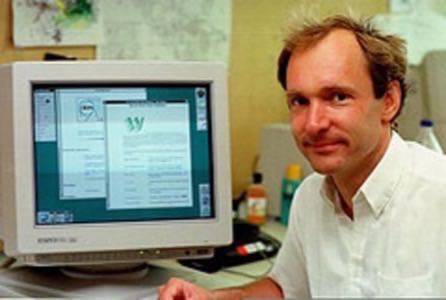Tim Berners-Lee, inventor of the World Wide Web, today published a blog post about what he terms the Graph, which is similar (if not identical) to his Semantic Web vision. Referencing both Brad Fitzpatrick’s influential post earlier this year on Social Graph, and our own Alex Iskold’s analysis of Social Graph concepts, Berners-Lee went on to position the Graph as the third main “level” of computer networks. First there was the Internet, then the Web, and now the Graph – which Sir Tim labeled (somewhat tongue in cheek) the Giant Global Graph!

Note that Berners-Lee wasn’t specifically talking about the Social Graph, which is the term Facebook has been heavily promoting, but something more general. In a nutshell, this is how Berners-Lee envisions the 3 levels (a.k.a. layers of abstraction):
1. The Internet: links computers
2. Web: links documents
3. Graph: links relationships between people and/or documents — “the things documents are about” as Berners-Lee put it.
The Graph is all about connections and re-use of data. Berners-Lee wrote that Semantic Web technologies will enable this:
“So, if only we could express these relationships, such as my social graph, in a way that is above the level of documents, then we would get re-use. That’s just what the graph does for us. We have the technology — it is Semantic Web technology, starting with RDF OWL and SPARQL. Not magic bullets, but the tools which allow us to break free of the document layer.”
Sir Tim also notes that as we go up each level, we lose more control but gain more benefits: “…at each layer — Net, Web, or Graph — we have ceded some control for greater benefits.” The benefits are what happens when documents and data are connected – for example being able to re-use our personal and friends data across multiple social networks, which is what Google’s OpenSocial aims to achieve.
What’s more, says Berners-Lee, the Graph has major implications for the Mobile Web. He said that longer term “thinking in terms of the graph rather than the web is critical to us making best use of the mobile web, the zoo of wildy differing devices which will give us access to the system.” The following scenario sums it up very nicely:
“Then, when I book a flight it is the flight that interests me. Not the flight page on the travel site, or the flight page on the airline site, but the URI (issued by the airlines) of the flight itself. That’s what I will bookmark. And whichever device I use to look up the bookmark, phone or office wall, it will access a situation-appropriate view of an integration of everything I know about that flight from different sources. The task of booking and taking the flight will involve many interactions. And all throughout them, that task and the flight will be primary things in my awareness, the websites involved will be secondary things, and the network and the devices tertiary.”
Conclusion
I’m very pleased Tim Berners-Lee has appropriated the concept of the Social Graph and married it to his own vision of the Semantic Web. What Berners-Lee wrote today goes way beyond Facebook, OpenSocial, or social networking in general. It is about how we interact with data on the Web (whether it be mobile or PC or a device like the Amazon Kindle) and the connections that we can take advantage of using the network. This is also why Semantic Apps are so interesting right now, as they take data connection to the next level on the Web.
Overall, unlike Nick Carr, I’m not concerned whether mainstream people accept the term ‘Graph’ or ‘Social Graph’. It really doesn’t matter, so long as the web apps that people use enable them to participate in this ‘next level’ of the Web. That’s what Google, Facebook, and a lot of other companies are trying to achieve.
Incidentally, it’s great to see Tim Berners-Lee ‘re-using’ concepts like the Social Graph, or simply taking inspiration from them. He never really took to the Web 2.0 concept, perhaps because it became too hyped and commercialized, but the fact is that the Consumer Web has given us many innovations over the past few years. Everything from Google to YouTube to MySpace to Facebook. So even though Sir Tim has always been about graphs (as he noted in his post, the Graph is essentially the same as the Semantic Web), it’s fantastic he is reaching out to the ‘web 2.0’ community and citing people like Brad Fitzpatrick and Alex Iskold.
Related: check out Alex Iskold’s Social Graph: Concepts and Issues for an overview of the theory behind Social Graph. This is the post Tim Berners-Lee referenced. Also check out Alex’s latest post today: R/WW Thanksgiving: Thank You Google for Open Social (Or, Why Open Social Really Matters).










